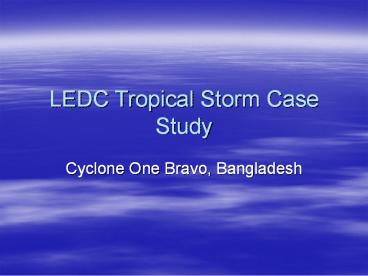LEDC Tropical Storm Case Study PowerPoint PPT Presentation
Title: LEDC Tropical Storm Case Study
1
LEDC Tropical Storm Case Study
- Cyclone One Bravo, Bangladesh
2
What do you need to revise?
- Where is the cyclone region?
- What happened?
- What were the human, economic environmental
effects of the cyclone? - How had things improved since 1991?
- What relief was available?
3
Where?
- Gathered intensity in Bay of Bengal and struck SE
coast of Bangladesh on 19th May 1997. - 250km per hr winds caused serious damage
flooding of the eastern coastal belt of
Bangladesh, home to approx 4 million people. - The worst effects felt along coastal areas such
as Chittong. - The winds continued northwards bringing
torrential rain to the Himalayas trapping 8 Mount
Everest base camp expeditions. - Effects were similar to those of the cyclone that
hit the same area in 1991 killing 140,000 but
this time death tolls were significantly lowered.
4
(No Transcript)
5
Human effects
- 111 people died, 700 injured.
- 500,000 made homeless.
- Wells contaminated by sea water.
- Disease was common.
- Communication links between Maheshkhali Island
and the mainland were severely disrupted.
6
Economic effects
- 608 schools damaged.
- Fishermen lost their incomes as boats and nets
were broken. - 30,000 hectares of land were damaged.
- 2000 cows died.
- Electricity supplies failed in most areas.
- Roads, bridges cyclone shelters were destroyed.
7
Environmental effects
- Fish ponds were contaminated.
- Flood embankments were damaged leading to
increased risk of flooding. - Many low lying islands in Bay of Bengal
destroyed. - Soil erosion in the foothills of Himalayas.
8
How had things improved since 1991?
- -Quick international aid response, CARE (Worlds
largest private international relief
development agency) - Low tide
- Protection schemes
- After many storms the Bangladeshi government had
become experts at lessening the death tolls. - With the help of International Aid materials for
building shelter, food, water, clothing, washing
resources were distributed to where they were
needed.
9
- Protection Schemes
- Earth embankments have been constructed but are
not high enough or strong enough. - In some areas cyclone shelters have been built,
made of concrete and constructed above floodwater
levels but in many areas the flimsy housing is
completely destroyed. - Education programmes have been implemented so
people know how to react and deal with a storm. - Tree Planting schemes to absorb the storm surge.
10
Why to people continue to live in areas prone to
tropical storms?
- LEDC
- Im a farmer and cant leave my land
- All my family live here
- I havent got enough money to live anywhere else
- Cyclones dont happen very often Ill be ok!
11
Why to people continue to live in areas prone to
tropical storms?
- MEDC
- All my friends are here
- Ive got good insurance
- My house is well built, it will be alright
- Ive got a good job and house. Why should I leave?
12
Typical Questions
- Give 3 reasons why people continue to live in
areas which are at risk from tropical storms. 3 - The effects of tropical storms are different if
they occur in an MEDC rather than an LEDC.
Explain how the effects are different. Refer to
examples you have studied. 5

